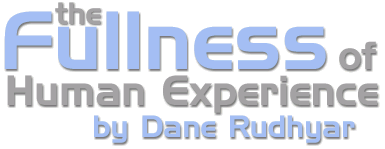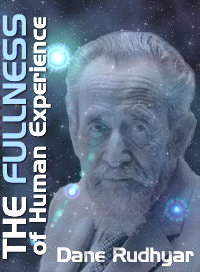 |
| Home | Bio | Art | Music | Literature | Civilization & Culture | Philosophy of Wholeness | Theosophy & Spirituality | Astrology |

CHAPTER THREE
The Cyclic Structure of the Movement of Wholeness - 3 Human free will and the process of readjustment In its most divine aspect, Compassion takes the form of the Godhead's desire to give to the at least partial failures of the past universe a new chance to experience Wholeness fully and concretely. Compassion inspires the vow Bodhisattvas are said to take as they renounce, through immense periods yet to unfold, the supreme bliss of Nirvana in order to be able to assist "all sentient beings" on this planet in experiencing this state of quasi-absolute subjectivity and oneness. This assistance undoubtedly takes forms it is impossible for the ordinary human mind to picture, because they refer to the evolution of humanity as a whole, and indeed of the earth as a planetary being. At a more understandable level of human existence, Compassion can take a multitude of less extensive and radical forms, yet none of these should be confused with merely personal emotions and above all with sentimental feelings. In the Gospels, when Jesus enjoins his disciples to "offer the other cheek" if an angry man has struck them, this kind of abnormal reaction to an experience is intended to be a deliberate, freely made attempt by a conscious and compassionate "I" to readjust the harmony of interactive relationships disturbed by the angry gesture — an act of readjustment being needed to re-equilibrate a situation disturbed by another act of opposite polarity. An extension of the principle of readjustment is implied in the desires of some human beings to lead lives of asceticism and prayer in order to restore the condition of wholeness thrown out of balance by the lusts and greeds of so many other persons, and indeed made commonplace features of interpersonal relationships and societal organizations. In this religious and quasi-mystical sense, "prayer" means establishing and maintaining open channels of mind and feelings, sustained by biological restraint and the transmutation of life-energies. Through these channels the planet-wide collectivity of transhuman and translucent beings (Saints, Bodhisattvas and true Holy Men) who have transcended the merely human mode of experiencing are able more focally and effectively to release the power needed to balance the unstructured desire for individual freedom, ego-originality, and personal-social attainment inherent in the human phase of the Movement of Wholeness. On the other hand, karma is a restructuring operation which takes place at a cosmic level and restores the invariant character of whole cycles of being by generating conditions of existence (and particularly of physical rebirth) which theoretically neutralize the previous acts or even thoughts of disorder produced by at least relatively free human agents. The original meaning of the word karma seems, however, to have been simply "action"; the implication being that every action produces a reaction, equal but in the opposite direction. This refers, therefore, to Newton's third law of motion, whose application is shown in jet-propulsion, the recoil of guns being fired, and in the results of a speeding car hitting a wall. But when we speak of action and reaction, we should first consider the meaning we give to the word motion. Newton's laws of motion imply the existence of material entities moving through space considered as an empty container; but such entities are not directly and originally experienced. The mind of a recently born child gives to a series of recurrent changes, periodically affecting his or her biological organism in a pleasantly or painfully remembered way, the character of entities — a character further emphasized and set by the names attributed to them by his or her family.(3) Infants and primitive people who interpret their collective experiences in animistic terms seem to think of motion as the result of some entity's actions. Even at the sophisticated and rationalistic level of classical European thinking, the Creation of all material entities was an act of God who, as causeless First Cause and "Prime Mover," created them "out of nothing" (ex nihilo), very much as a dramatist imagines a new situation which he intends to make into a play, but whose development has a will of its own and needs to be watched — a thoroughly anthropomorphic concept! A much-needed alternative is the idea of perpetual cyclic motion without beginning or end. There is neither beginning nor end in the sense that a whole of motion (a cycle, an Eon) can be made to begin with any phase of the movement. Any situation, as a particular phase of the entire movement, is related to the whole cycle, rather than to an original "mover" or to any other entity participating in the total state of equilibrium of the cyclic motion. An unstructured and at least relatively free action which actualizes an egocentric, un-rhythmic desire for comfort, hurried growth, or power, has to be compensated for and balanced by the whole cycle whose structural equilibrium it has disturbed. Karma does not mean that the person you killed will have to kill you in a future encounter; this would engender an endless series of killings. The disturbance in the Movement of Wholeness, produced by the destructuring and chaotic gesture, has to be absorbed by the whole cycle. It is absorbed positively and spiritually by divine or quasi-divine acts of Compassion. Individual human beings in their limited human capacity can begin to perform such acts. These will be gathered and integrated in Pleroma states of being transcending the human level — states which, at the symbolic Midnight, reach their near-perfect fulfillment in the Godhead. In other words, karma is the compulsive aspect of the Presence of Wholeness upon a whole that had acquired the capacity to choose between a path of "light" that leads to the full and nearly all-inclusive experience of the Godhead, and the path of "darkness" whose inevitable end is the nearly absolute emptiness and total isolation of an "I" utterly devoid of substance or potency. The latter condition is the opposite of the Godhead state of supreme plenitude; and it can be symbolized by a center without a circle, a mandala without contents. Beness incapable of being. Nevertheless, Wholeness includes the two opposite paths. It also includes the possibility of freedom of choice inherent in the human situation. Because of this possibility, the state of personhood and the culture necessary for its development constitute the critical area of the entire Movement of Wholeness. In the next chapters I shall again consider the meaning of this human phase of the whole process of being. 3. The process of formation of the ego is discussed in my book Planetarization of Consciousness and in the booklet Beyond Personhood (San Francisco, California: Rudhyar Institute for Transpersonal Activity, 1982). I shall return to it in later chapters. Return By permission of Leyla Rudhyar Hill Copyright © 1986 by Leyla Rudhyar Hill All Rights Reserved.  Web design and all data, text and graphics appearing on this site are protected by US and International Copyright and are not to be reproduced, distributed, circulated, offered for sale, or given away, in any form, by any means, electronic or conventional. See Notices for full copyright statement and conditions of use. Web design copyright © 2000-2004 by Michael R. Meyer. All Rights Reserved. |
 |
